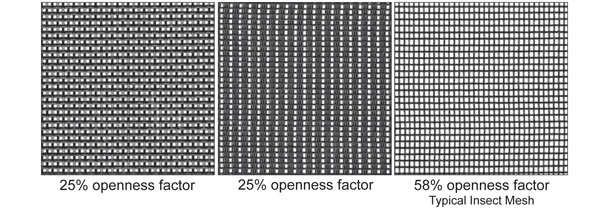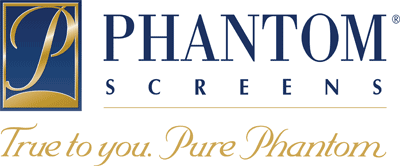Comfort on Demand
Component Parts
Architects interested in specifying sustainable materials should have an understanding of the component parts of retractable screens.
Mesh and Durability
Most motorized retractable screens are made of either high-strength fiberglass or polyester yarn that is interlocked, heat-treated for secure bonding and coated with a vinyl compound that has been engineered for durability, fire and fade resistance, soiling and general wear and tear. When PVC coated fiberglass is woven together, it creates a material with high tensile strength, high heat resistance; inherent flame resistance; dimensional stability; chemical resistance; and low moisture absorption. Fiberglass yarns are manufactured from natural minerals, including quartz, sand, soda and lime, which are non-toxic. The strength of both polyester and fiberglass mesh adds to the durability of the product and thus its sustainability.

Mesh products undergo weatherization tests (TMS-TM-003) for colorfastness. The test is used to determine the change in color (fading) when exposed to various weathering conditions such as heat, rain and humidity. The standard for the industry is 1200 QUV hours. The change in color is evaluated according to the American Association of Textile Chemists and Colorists according to a chart with degrees of shading in gray (gray scale); 1 is the most dramatic change and 5 rated as no change. Architects should note that 4 is a slight change and is the value assigned to many sun control products.
A few maintenance procedures are worth noting. Though mesh does not absorb water, rain may adhere to it. The brush system hidden near the roller will eliminate some moisture but consideration should be given to drainage if a recessed cavity is designed. Although agents are added to the vinyl formulation to resist the growth of mold and mildew, some environments are more conducive to mildew growth than others. For instance, a rolled up, wet shade in the humid Florida climate would probably be more prone to mildew growth than a shade in Phoenix, Arizona. Usually the origin of the mildew is from a source of contamination that offers a breeding ground for the organism; it can be removed by washing the screens with a mild dish detergent and warm water solution.
Choosing Material That is Recyclable and Non-Toxic
Typically the exposed hardware - including housing, slidebars and tracks - of retractable screens - is constructed of extruded aluminum which is generally powder coated in various colors. Unlike liquid paint, a powder coating does not require a solvent and so emits zero or near zero volatile organic compounds, which have a range of health consequences. Powder coatings also result in thicker coatings without runs or sagging, and because the overspray can be recycled, achieving nearly 100 percent use of the coating is possible.
Aluminum is light, strong, durable, noncorrosive, low maintenance and one of the most abundant elements in the earth's crust. While aluminum consumes more energy than most building products during manufacturing, its end use products result in some of the most energy-efficient available.
Maintaining Retractable Screens for Increased Longevity
While retractable screens are typically a low maintenance product, some issues are worth noting to ensure longer product life.
Screens should be retracted into protective storage housings when not in use. Objects left under a motorized unit can prevent the unit from lowering. Should this occur, the slide bar should be lifted manually, the obstacle removed, and the slide bar lowered. Interruption of power will not erase the memory of the control program.
Tracks should be kept free of dirt and debris which may cause the screen to perform poorly; they should be periodically cleaned and lubricated. Mesh fabric, housing tracks and slide bar can be cleaned with water and a soft brush but not with a pressure washer. A mild detergent can be used, but not chemicals.
Motorized units should be retracted in winds in excess of 25 miles per hour (40 kilometers per hour) as the wind load may affect the ability of the unit to extend or retract. The screens should never be used solely for the purpose of a wind break. Neither should snow or ice be allowed to accumulate on the fabric or tracks. The motorized screens should not be used in temperatures under 14 degrees F. (-10C), although they can be operated infrequently at -4 degrees F (-15C).
Specifying Early for Maximum Efficiency
With the realization that controlling the levels of light and heat entering a building can reduce operating costs, make buildings more comfortable, and occupants more productive, a building façade is more than an aesthetic solution and should be approached in a more holistic way.
The benefits of specifying automated solar shading from the design stage are clear. Motorized retractable screens are an engineered product that should be considered early on so that components can be integrated into the structure. For new construction, the roller and motor assembly, and often the track as well, can be recessed into the building design so that they become invisible. Dimensions of the cavity must be specified by the manufacturer but range from 4 inches (10 centimeters) to 6 ½ inches (16 centimeters) deep by 6 ½ inches (16 centimeters) to 10 inches (25 centimeters) high in order to hide the roller assembly and bottom slide bar. An access panel must be provided for the full width of the unit in order to service the motor and screen.
A Sustainable Option
As architects continually move to design buildings with reduced carbon footprints and greater connection with the environment, the ability to maximize effective daylighting, natural ventilation and views to the outdoors will all assume increasing significance. Because of their functionality in all these areas, retractable screens will be viable options across all building types to contribute to architecture that reflects the principles of sustainability and human health and well being.
Â
|









